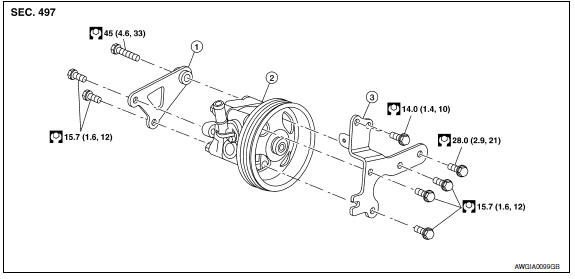Nissan Maxima Service and Repair Manual: Power steering oil pump
Exploded View

- Rear bracket
- Power steering oil pump assembly
- Front bracket
Removal and Installation
NOTE: When removing components such as hoses, tubes/lines, etc., cap or plug openings to prevent fluid from spilling.
REMOVAL
- Remove front wheel and tire (RH) using power tool. Refer to WT-60, "Adjustment".
- Remove front fender protector side cover. Refer to EXT-23, "Exploded View".
- Remove hood ledge cover (RH).
- Drain power steering fluid. Refer to ST-12, "Draining".
- Disconnect the power steering pressure sensor harness connector at the high pressure pipe. Refer to ST- 29, "Exploded View".
- Disconnect high pressure piping and suction hose from power steering oil pump. Refer to ST-29, "Exploded View".
- Loosen drive belt. Refer to EM-14, "Removal and Installation".
- Remove drive belt from power steering oil pump pulley.
- Remove power steering oil pump bolts, and then remove power steering oil pump.
INSTALLATION
Installation is in the reverse order of removal.
- When installing power steering oil pump, install all bolts by hand initially, then tighten bolts to specification.
- Perform the following procedures after installing.
- Check belt tension. Refer to EM-14, "Checking Drive Belts".
- Bleed air from power steering system.
 Steering gear and linkage
Steering gear and linkage
Exploded View
Cotter pin
Steering gear assembly Front
Removal and Installation
NOTE: When removing components such as
hoses, tubes/lines, etc., cap or plug openings to prevent fluid ...
 Hydraulic line
Hydraulic line
Exploded View
High pressure hose
Suction hose
Reservoir tank bracket
Reservoir tank
Oil pump assembly
Steering gear assembly
Low pressure piping
Eye bolt
High pressure pipin ...
Other materials:
Precaution
PRECAUTIONS
Precaution for Supplemental Restraint System (SRS) "AIR BAG" and
"SEAT BELT PRE-TENSIONER"
The Supplemental Restraint System such as "AIR BAG" and "SEAT BELT
PRE-TENSIONER", used along with a front seat belt, helps to reduce the risk
or severity of injury to the driver and front ...
Low brake fluid warning light
When the ignition switch is placed in the ON
position, the light warns of a low brake fluid level.
If the light comes on while the engine is running,
with the parking brake not applied, stop the vehicle
and perform the following:
1. Check the brake fluid level. Add brake fluid
as necessary. ...
B2632, B2633 air mix door motor (driver side)
Description
COMPONENT DESCRIPTION
Air Mix Door Motor (Driver side)
The air mix door motor (driver side) (1) is attached to the heater
&
cooling unit assembly.
It rotates so that the air mix door is opened or closed to a
position
set by the A/C auto amp.
Motor rotation is then ...
Nissan Maxima Owners Manual
- Illustrated table of contents
- Safety-Seats, seat belts and supplemental restraint system
- Instruments and controls
- Pre-driving checks and adjustments
- Monitor, climate, audio, phone and voice recognition systems
- Starting and driving
- In case of emergency
- Appearance and care
- Do-it-yourself
- Maintenance and schedules
- Technical and consumer information
Nissan Maxima Service and Repair Manual
0.0069
